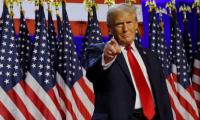KARACHI: Pakistan is an unusual place for cars. You can buy a new vehicle, drive it for years, and sell it at a higher price, Bloomberg reported on Friday.
Muhammad Rameez, head of sales at Foundation Securities Pvt., says he purchased a new hatchback from the local unit of Suzuki Motor Corp. in 2019. After driving it 12,000 kilometers in Karachi, Rameez got it valued three years later at 65 percent higher than the original price. A Toyota Corolla purchased new for 2 million rupees ($8,766) five years ago can be sold in the used car market for 3.2 million rupees today, an increase of 60 percent before adjusting for inflation, according to Karachi-based Optimus Capital Management Pvt.
A falling currency, protectionist market, and high inflation all contribute to the rising value of cars —and a frenzied market for used ones. Middlemen, often referred to as “investors,” buy new automobiles in bulk and sell them at a premium. Pakistani customers paid that surcharge, known locally as “own money,” on 90 percent of vehicle sales for a total of 170 billion rupees over the last five years, according to the Pakistan Institute of Development Economics.
“The investor’s objective is short-term financial gain,” says Muhammad Faisal, president of the automotive division of Lucky Motor Corp., which sells Kias and Peugeots. “When we speak to other global manufacturers, they are amazed that people give extra money to buy a car.”
The alternative can cost more. When Subhan Mohsin Ahmed ordered a 2022 Honda Civic in March, it cost 5.3 million rupees, and he was told delivery would take a year. Since then, the price has shot up 33 percent and it’s expected to rise further. Pakistani contracts require customers to pay a portion of the price at the time of booking and the majority on the day of delivery.
At the UP Morr bazaar in the neighborhood of New Karachi, millions of rupees of used cars trade hands every Sunday evening. Tickets to the grounds, which accommodate some 2,000 vehicles, cost about 300 rupees—but some traders make deals on nearby roads as well.
Regular boom-bust cycles have pushed Pakistan into 13 loan programs from the International Monetary Fund since the late 1980s, and per capita income has stayed broadly unchanged. Inflation is among the fastest in Asia and the rupee has dropped almost 300 percent since 2000.
Stagnant living standards keeps the nation’s market small, with sales of 120,000-220,000 cars for most years since 2004.
That makes it unfeasible to open large factories. Companies instead import components—as much as 90 percent of the typical car—and assemble the vehicle locally.
Assemblers build cars after receiving orders, instead of in anticipation of demand, so customers often have to wait as long as a year before they receive their delivery.
A similar trend can be seen in other countries that face regular currency depreciation, according to frontier markets investor Tundra Fonder AB.
“In most of our markets, which have relatively stable currencies, we didn’t notice this factor,” says Mattias Martinsson, Tundra Fonder’s chief investment officer. “But Egypt has similar characteristics to Pakistan’s automobile industry.”
When Lucky Group introduced Kia cars to Pakistan in 2019, the company wanted to see the cars on the roads instead of in used-car showrooms. So employees plowed through the list of buyers who visited the showroom to ensure there weren’t any investors among them.
Muneeb Gulzar, the owner of used-car dealer Sam Automobiles, specializes in selling high-end imported cars such as Audis and Porsches in Karachi. He says he’s in no hurry to get them out of the showroom.
“The longer these cars sit over here, the more valuable they get,” he explains.
Honda officials posing for a photgraph. —APP/FileKARACHI: Honda Atlas Cars Pakistan Ltd has achieved a major...
SOS children village's children showing bags donated by Emirates International Airlines. — Emirates...
Automobiles at the shipping terminal are shown from the view of a drone in San Diego, California, US, March 26, 2025....
Key challenge lies in whether the ruling elite is willing to implement changes that could weaken their grip on power
A woman holds a smartphone displaying the logo of social network X . — AFP/FileElon Musk said his xAI artificial...
A representational image of a person using his cellphone for a digital transaction. — Unsplash/FileKARACHI: Chief...







